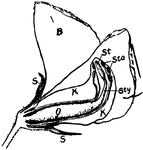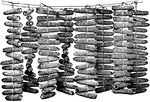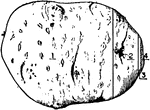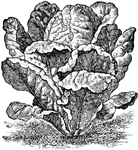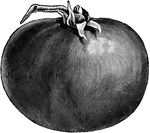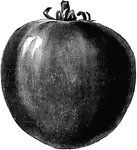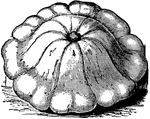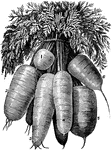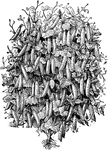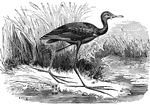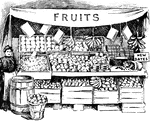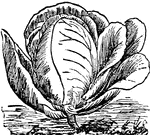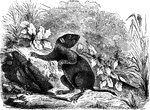
Black Pephagomys
"This is five inches long, of a black color, and has nearly naked ears; it feeds on vegetable substances,…

Radish
View of a radish, illustrating the root-hairs, which absorb most of the water the plant needs.
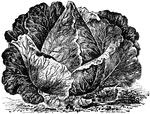
Charleston Wakefield cabbage
A Charleston Wakefield cabbage, a pointed head cabbage popular among Florida growers.

Hodson Wax Beans
A Hodson Wax Bean plant, well-suited to Florida. It is nearly immune to rust and is a very heavy bearer.
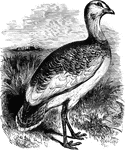
Great Bustard
Forty-five inches in length, the great bustard feeds on green wheat, grapes, trefoil, and other vegetable…

Bream
"It is abundant in the larer lakes and quiet rivers of Great Britain and Ireland. It swims in shoals;…

Redeye
"Is a very common fish in Europe; it is of brilliant colors, and very tenacious of life; it feeds on…

Cocktails
"The larvae are very similar to the perfect insects, both in appearance and habits. Many of them feed…

Earwigs
"The Foficulina includes the Earwig, Forficula, which appears to live principally upon vegetable…
!["Like that animal [the mole] it is constantly engaged in burrowing in the earth; and to enable it to do this with facility iits anterior limbs are converted into a pair of flat, fossorial organs, which are turned outward in exactly the same manner as the hand of the mole. In its pasage through the earth it does great injury to the roots of plants, but it said to live quite as much upon animal as vegetable food." — Goodrich, 1859](https://etc.usf.edu/clipart/14900/14935/molecricket_14935_mth.gif)
Mole Cricket
"Like that animal [the mole] it is constantly engaged in burrowing in the earth; and to enable it to…
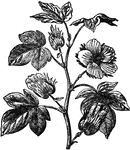
Cotton Plant
"Cotton is a vegetable hair or filament constituting the wing of the seed of the different species of…
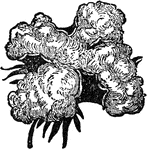
Cotton Flower
"Cotton is a vegetable hair or filament constituting the wing of the seed of the different species of…
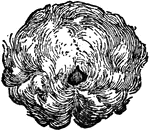
Cotton Flower
"Cotton is a vegetable hair or filament constituting the wing of the seed of the different species of…
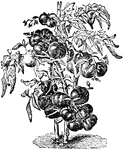
Tomato Plant
"Tomato, or Love Apple, is a plant of the natural order Solanaceæ. It is one of a genus of several…
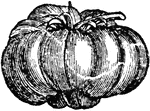
Tomato
"Tomato, or Love Apple, is a plant of the natural order Solanaceæ. It is one of a genus of several…

Tomato
"Tomato, or Love Apple, is a plant of the natural order Solanaceæ. It is one of a genus of several…

Hairy Nosed Wombat
"The Wombat is a burrowing marsupial from Australia and Van Dieman's Land, and the islands of Bass'…
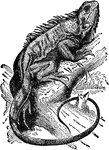
Iguana
"Iguana is a genus of saurian reptiles, natives of Brazil, Cayenne, the Bahamas, and neighboring localities…

Kangaroo
"The Kangaroo is an animal of Australia, first observed by a party of sailors on the coast of New South…

Lizard
"Lizard is the popular name of numerous reptiles having usually two pairs of limbs and an elongated…
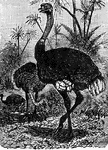
Ostrich
"The Ostrich is the largest of all living birds, standing from six to eight feet in height, and has…
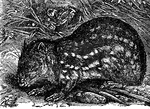
Paca
"The Paca is a small South American rodent, allied to the guinea pig. It lives singly or in pairs, passing…

Phalanger
"The Phalanger is a small woolly-coated marsupial, with opposable great toes, which are destitute of…
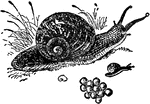
Snail
"Snail is the common name of gasteropodous mollusks. They feed chiefly on vegetable substances, though…
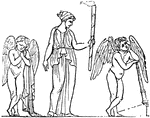
Fax
"A torch. In the annexed woodcut, the female figure is copied from a fictile vase. The winged figure…

Tadpole
"The Tadpole is the larva of the anurous amphibia, sometimes so far extended as to include larvaæ…

Tadpole
"The Tadpole is the larva of the anurous amphibia, sometimes so far extended as to include larvaæ…

Frog Eggs
"The Tadpole is the larva of the anurous amphibia, sometimes so far extended as to include larvaæ…

Frog Egg
"The Tadpole is the larva of the anurous amphibia, sometimes so far extended as to include larvaæ…

Fungi
"These may be placed at the very bottom of the vegetable scale, and are observable in a great variety…
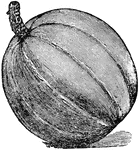
Pumpkin
A pumpkin is a vegetable, most commonly orange in colour when ripe, that grows as a fruit from a trailing…

Radish
A fleshy plant grown extensively as a garden vegetable. It is thought to be native to India, where it…

Grotesque
"A style of classical ornament, so called, in the 13th century from its having been rediscovered in…

Brachelytra
"Readily distinguished from the other groups of beetles by having the elytra much shorter then the abdomen,…

Types of Zoogloea
"A. Mixed Zoogloea found as a pellicle on the surface of vegetable infusions &c; it consists of various…


